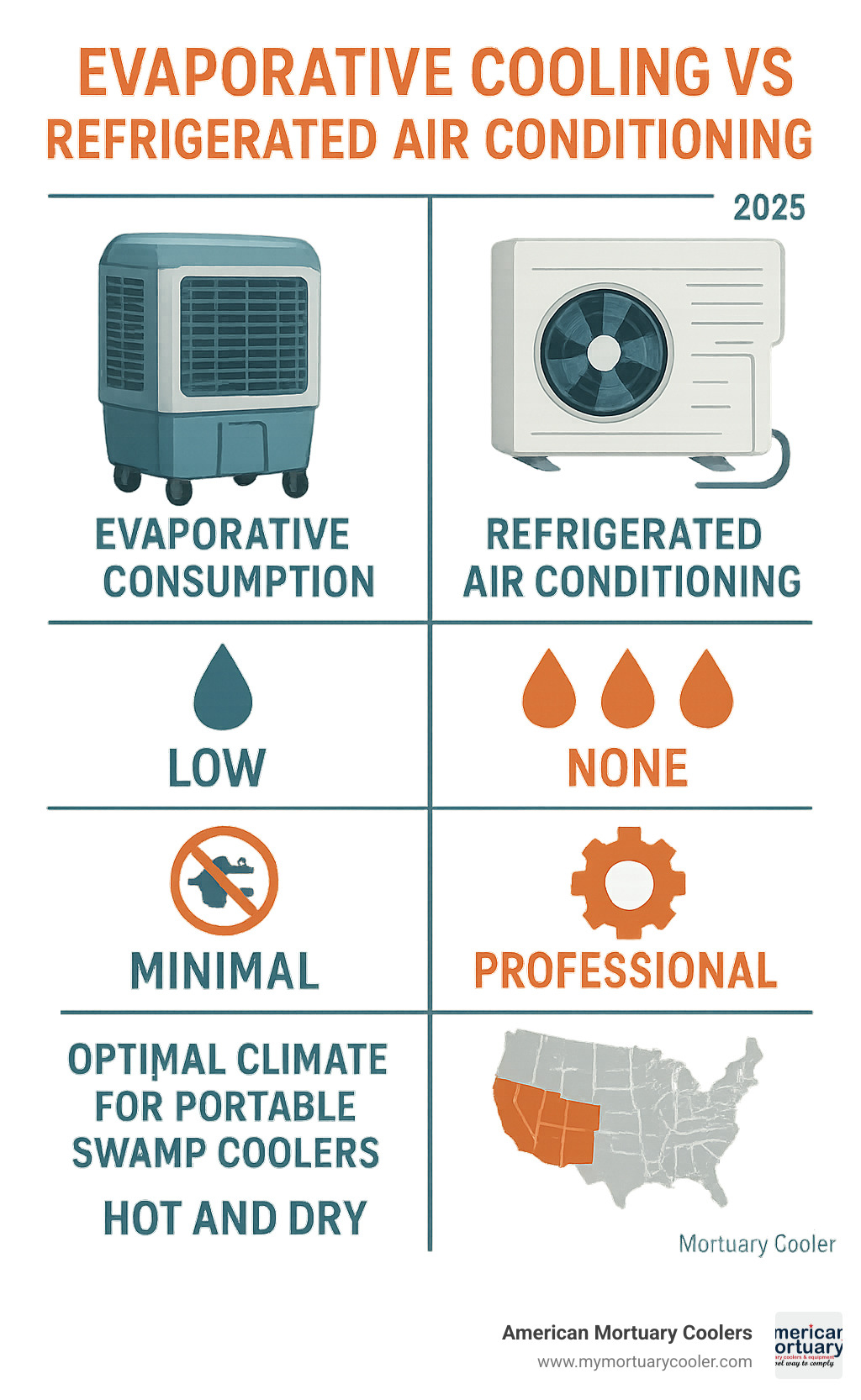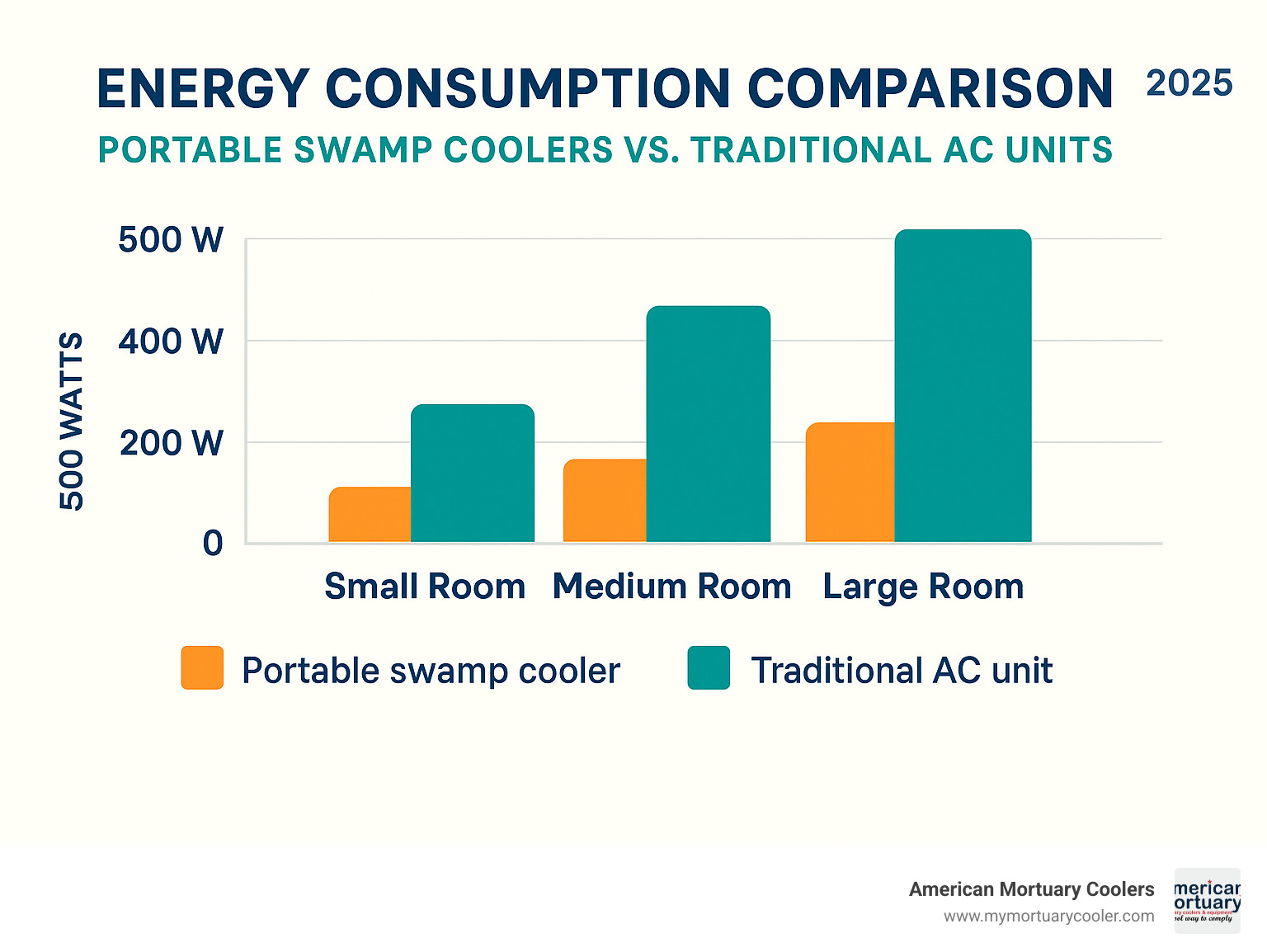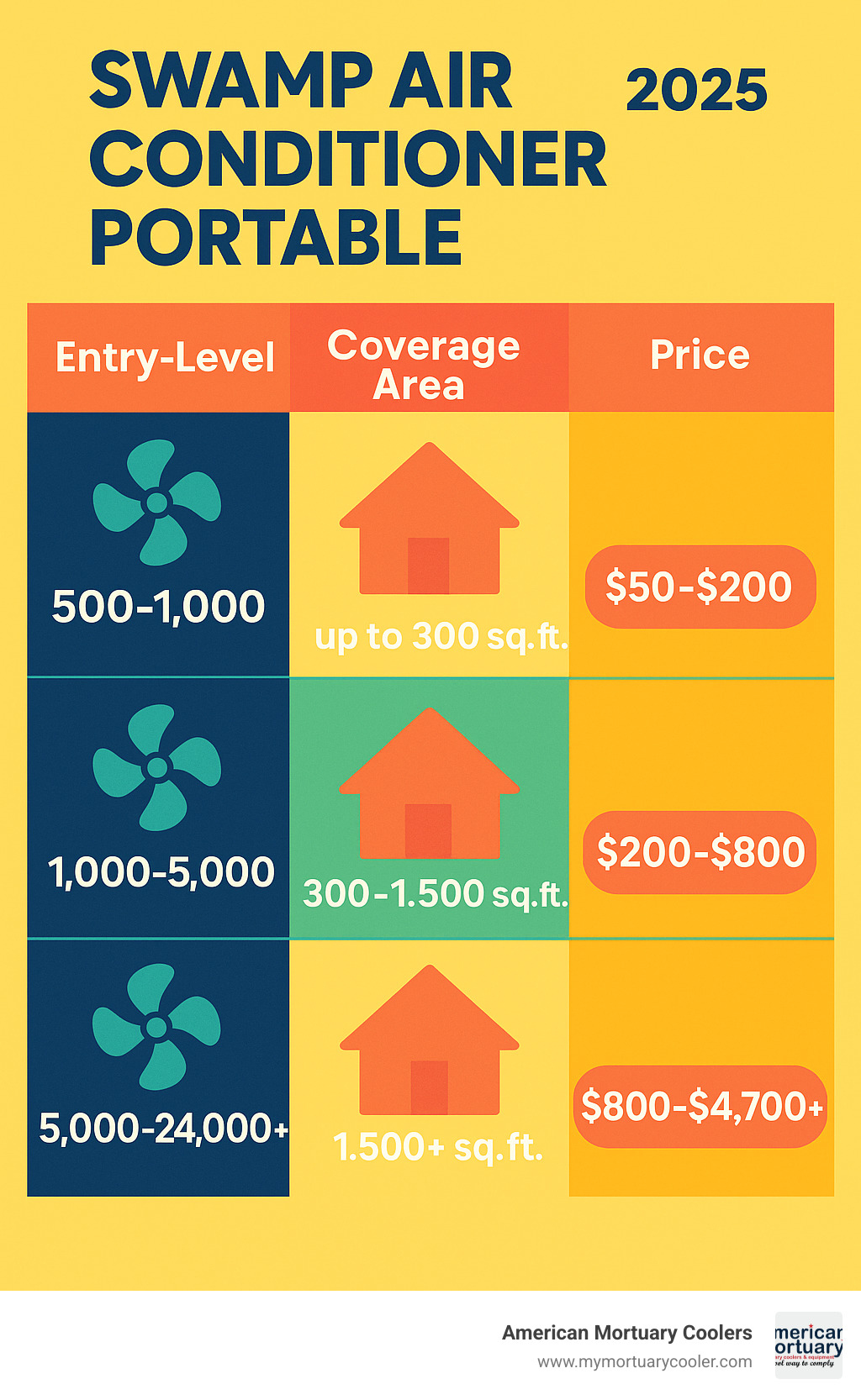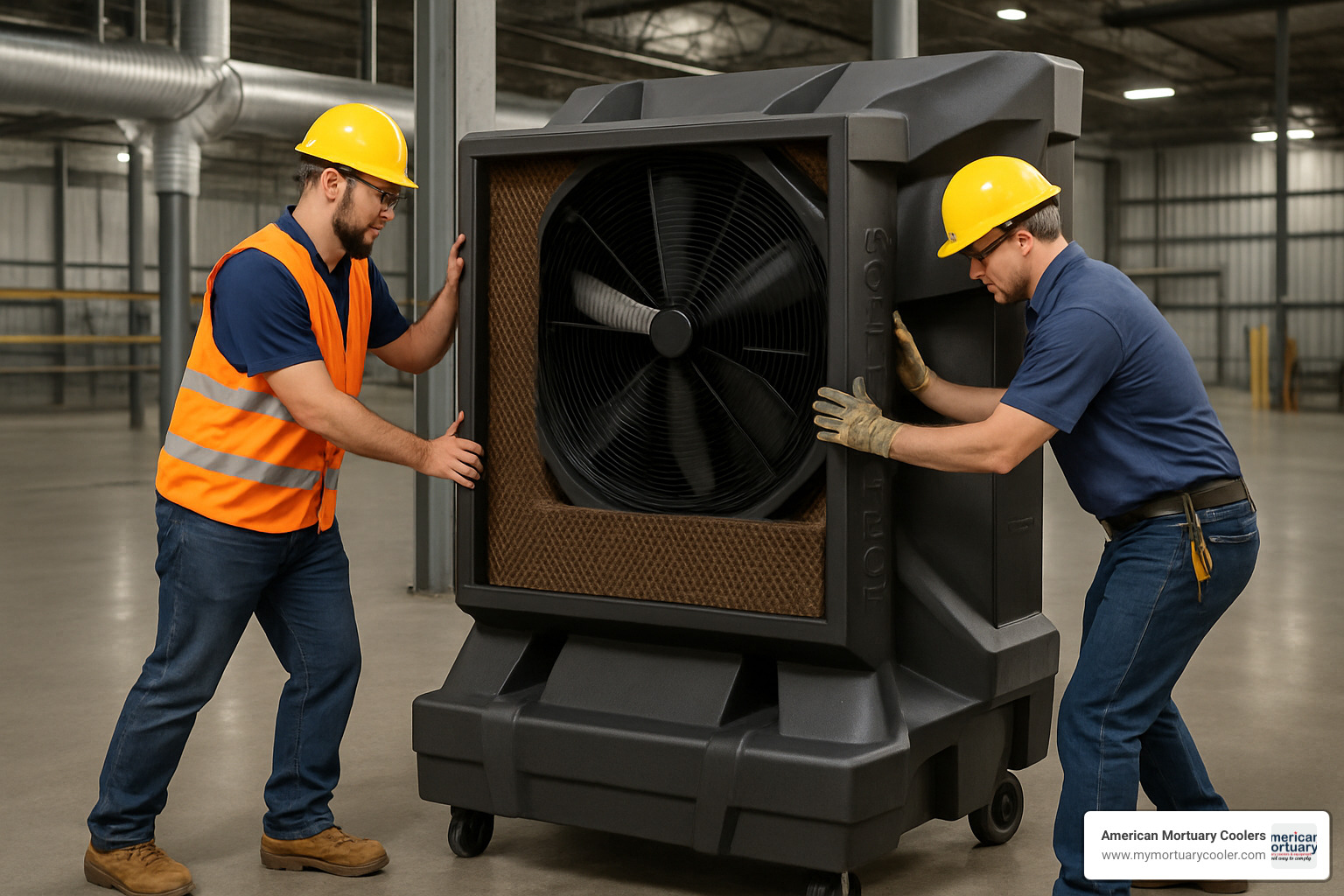Why Portable Swamp Air Conditioners Are Perfect for Hot, Dry Climates
A swamp air conditioner portable unit offers an energy-efficient cooling solution that works by drawing warm air through water-soaked pads to reduce temperatures by up to 30 degrees. These evaporative coolers are ideal for hot, dry climates and can cool spaces ranging from 350 to 6,500 square feet depending on the model.
Quick Facts About Portable Swamp Air Conditioners:
- How they work: Water evaporation cools incoming air (no compressor needed)
- Best climates: Hot and dry regions with humidity below 60%
- Coverage area: 350-6,500 sq ft depending on CFM rating
- Price range: $88 for basic models to $4,700+ for industrial units
- Energy use: 70% less power than traditional AC units
- Setup: No installation required - just add water and plug in
Unlike traditional air conditioners that use refrigerants and compressors, portable swamp coolers use simple evaporation to create cooling. They work best in arid regions like the Southwest and Midwest, where low humidity allows maximum evaporation efficiency.
Popular models include:
- Hessaire MC37M: 3,100 CFM, cools 950 sq ft ($387)
- Big Ass Fans Cool-Space 500: 24,000 CFM, cools 6,500 sq ft ($4,750)
- Portacool Apex series: Wi-Fi enabled with smartphone control
I'm Mortuary Cooler, a national-level mortuary cooler supplier with experience in cooling solutions for specialized facilities. Through years of working with temperature-controlled environments, I've gained valuable insights into how different cooling technologies, including swamp air conditioner portable units, perform in various conditions and applications.

Easy swamp air conditioner portable glossary:
How Portable Swamp Air Conditioners Work
Ever wonder how a swamp air conditioner portable can cool your space without all the complex machinery of traditional AC units? The answer lies in one of nature's oldest cooling tricks - evaporation.
Think about stepping out of a swimming pool on a hot day. As the water evaporates from your skin, you feel cooler. That's exactly what happens inside a portable swamp cooler, just on a much larger scale.
Your swamp air conditioner portable pulls hot, dry air through a powerful fan system. This air then passes through special wet media - usually thick, honeycomb-shaped cooling pads that are constantly soaked with water. As the hot air moves through these saturated pads, water molecules evaporate into the air stream, stealing heat energy in the process. What comes out the other side? Cool, refreshing air that's typically 15-30 degrees cooler than what went in.
The whole system runs on just a few key components. The water tank holds anywhere from 1 to 19 gallons depending on your unit's size. A small water pump keeps circulating water to the cooling pads, ensuring they stay properly saturated. Meanwhile, the fan system does the heavy lifting of moving air through the wet media and out into your space.
What makes this so much better than traditional AC? No compressor needed. That's the part of regular air conditioners that guzzles electricity and makes all that noise. Without it, your portable swamp cooler uses about 70% less energy than conventional units. A model like the Coolzy-Go only draws 340 watts, while a similar-sized traditional portable AC might use over 1,000 watts.
Evaporative Cooling 101
The science behind why this works so well gets into something called psychrometrics. It all comes down to understanding two types of temperature readings.
Dry-bulb temperature is what you see on a regular thermometer - the actual air temperature. Wet-bulb temperature is the coolest temperature you can achieve through evaporation alone. In dry climates, there's a big gap between these two numbers, and that gap is where your swamp air conditioner portable works its magic.
Picture a hot day in Arizona where it's 100°F outside with only 20% humidity. A quality portable swamp cooler can bring your indoor temperature down to a comfortable 70-75°F because there's so much room for evaporation to occur. The drier the air, the more dramatic the cooling effect.
But here's the catch - this amazing performance only happens in dry climates. Once humidity climbs above 60%, the air is already holding too much moisture for significant evaporation to occur.
Comparing Energy & Water Use
Energy consumption varies dramatically between the two technologies. Small swamp air conditioner portable units use just 100-400 watts, while medium-sized models typically draw 400-1,500 watts. Compare that to traditional portable AC units that consume 1,000-4,000 watts.
In practical terms, running a portable swamp cooler costs about $0.02 to $0.18 per hour depending on size and local electricity rates. Traditional portable AC units cost $0.12 to $0.48 per hour to operate.
Water usage is the trade-off you make for those energy savings. Smaller units under 1,000 CFM use about 1-3 gallons per day. Medium-sized units in the 1,000-5,000 CFM range consume 3-8 gallons daily. The big industrial models over 5,000 CFM can use 8-15 gallons per day.
Even with the water usage factored in, the eco-footprint remains much smaller than traditional air conditioning. Swamp coolers don't use harmful refrigerants that can damage the ozone layer, making them a genuinely green cooling option for hot, dry climates.

Benefits & Limitations of Portable Swamp Coolers
A swamp air conditioner portable can be a lifesaver in a baking garage or at an outdoor event, but it is not a one-size-fits-all solution.
Key advantages
- Low operating cost – up to 70 % less electricity than compressor AC, so summer power bills stay reasonable.
- Plug-and-play setup – wheel it in, add water, plug it into a standard outlet.
- Indoor / outdoor versatility – one unit can follow you from shop to patio.
- Adds fresh, filtered air instead of recirculating the same stale air.
- Off-grid friendly 12 V options and zero refrigerants keep the eco-footprint small.
Real-world limitations
- Climate dependent – performance drops fast once humidity passes ~60 %.
- Extra moisture can feel muggy and may encourage mold if ventilation is poor.
- Cooling delta is moderate (15-30 °F), not the deep chill of refrigerated AC.
- Fan noise is noticeable on high speeds.
Key Advantages for Workshops & Events
Shops and event planners love the fast setup and mobility. Industrial models such as the Big Ass Fans Cool-Space 500 move up to 24,000 CFM, covering 6,500 ft², while remaining pet- and child-safe because there are no hot surfaces or refrigerants.
Common Drawbacks in Humid Regions
In the Southeast, Gulf Coast, or any area that often hits 70 % humidity, these coolers can make spaces feel stuffier, raise mold risk, and leave condensation on windows and tools. In those climates, traditional AC or hybrid strategies work better.
Choosing the Right swamp air conditioner portable
Finding the perfect unit boils down to three things: size of the space, expected runtime, and must-have features.
- CFM rating – match airflow to room volume. A 350 ft² garage needs roughly 1,500 CFM; a 2,000 ft² workshop may need 8,000 CFM or more.
- Tank size & runtime – 1-5 gal tanks last 4-12 hr; 10-19 gal models can run all day or be tied to a garden hose for continuous use.
- Feature set – basics like multiple speeds and a remote are non-negotiable. Upgrades such as Wi-Fi, auto-refill, UV-resistant housings and variable-speed motors make life easier if you’ll use the cooler daily.
For larger commercial applications, see our Best Industrial Coolers for Your Business Needs guide.
swamp air conditioner portable Sizing Guide
- Volume = length × width × height
- Air changes per hour (ACH) – 15-40 depending on heat load
-
CFM = (Volume × ACH) ÷ 60
Add 10 % CFM for every 1,000 ft elevation above sea level.
Example: 20′×20′×10′ shop = 4,000 ft³. At 20 ACH you need ~1,333 CFM.
Top Features Checklist
- Remote or app control
- Multiple fan speeds / variable motor
- Easy-fill tank with level indicator
- Rugged, locking casters
- Optional hose auto-refill for set-and-forget operation

Setup, Maintenance & Safety
Give the cooling pads a 15-minute pre-soak, place the unit near an open door or window for cross-ventilation, fill with clean water (filtered if you have hard water), then plug it into a GFCI-protected outlet. Test each speed and make sure the pump is circulating before you walk away.
Routine Cleaning Steps for swamp air conditioner portable Units
- Weekly: top up water, inspect pads, wipe exterior.
- Monthly: remove and rinse pads, descale the tank with a 1:1 white-vinegar mix, clean intake screens, and flush the pump line.
- Seasonal storage: drain completely, dry pads before storage, and keep the unit in a dry, ventilated spot.
Best Practices for Indoor Operation
Provide at least 1–2 ft² of open window per 1,000 CFM, keep humidity under 70 %, and set a small tray under the cooler to catch accidental drips.
For those curious about how evaporative cooling compares to other technologies, our Stay Cool, Stay Fresh: Top Refrigerated Coolers Reviewed article dives into the differences.
Comparing Leading Brands & Smart Options
After years of field use, we see a few brands stand out:
- Hessaire MC37M – 3,100 CFM, 950 ft² coverage, ~$387. Reliable workhorse for most garages.
- Portacool Apex series – Wi-Fi CoolSync, 55 ft air throw, hose auto-refill.
- Big Ass Fans Cool-Space 500 – 24,000 CFM for up to 6,500 ft²; built for daily commercial duty.
- Honeywell – 19 gal tanks and 33 ft air throw – a favorite for outdoor events.
- Budget picks – Arctic Air personal units (~$50) and VEVOR home models ($200-400) cover desks or small rooms.
Smart swamp air conditioner portable Models
The Portacool CoolSync app lets you schedule runtimes, receive low-water alerts and control multiple units from one dashboard.
Budget vs. Premium Picks
- Entry-level ($50-200) – USB or 120 V, 500-1,000 CFM, best for personal spaces.
- Mid-range ($200-800) – 1,000-5,000 CFM, remote control, 5-10 gal tanks; ideal for shops.
- Industrial ($800-4,700+) – 5,000-24,000 CFM, smart controls, hose hookup, and heavy-duty frames.

Frequently Asked Questions about Portable Swamp Coolers
What climate is best for a swamp air conditioner portable?
Hot, dry air is essential. Areas like Arizona, Nevada, West Texas, Colorado high plains, and much of the Southwest stay under 60 % humidity, allowing evaporation to drop temps 15-30 °F. In persistently humid zones (Gulf Coast, Deep South, coastal FL) performance is limited.
How often should I change the cooling pads?
With clean water and normal use, pads last 1–2 years. Hard water, daily 8-hour operation, or dusty shops shorten that to 6–12 months. Replace sooner if airflow drops or odors appear.
Can I run a portable swamp cooler and AC together?
Better to avoid it. The swamp cooler adds moisture while the AC tries to remove it, forcing both systems to work harder and wasting energy. Use evaporative cooling in spring/fall or in non-conditioned zones, and switch to AC during peak humidity.
Conclusion
When you're sweating through another scorching day in your garage or workshop, a swamp air conditioner portable unit might just be your cooling salvation. But here's the thing - these aren't magic boxes that work everywhere. They're incredibly effective when you match them to the right conditions, and pretty disappointing when you don't.
The sweet spot for portable swamp coolers is those hot, dry regions where humidity stays below 60%. Think Arizona summers, not Florida heat waves. In the right climate, these units can drop temperatures by 15-30 degrees while using 70% less energy than traditional AC. That's real money back in your pocket every month.
Getting the most from your investment means paying attention to the details. Size your unit properly - don't try to cool a 2,000 square foot warehouse with a personal desktop model. Position it where air can flow freely, and yes, you'll need to keep those maintenance schedules. Clean pads and fresh water aren't optional if you want consistent cooling.
From our experience at American Mortuary Coolers here in Tennessee, we understand that proper temperature control makes all the difference in any workspace. While we focus on specialized cooling for funeral facilities, the fundamentals remain the same across industries. Whether you're preserving dignity in our line of work or just trying to make your hobby shop bearable in July, the right cooling technology matched to your environment is what matters.
The reality check is simple: if you live somewhere humid, don't fight nature. A swamp air conditioner portable won't perform miracles in muggy conditions. But if you're dealing with dry heat, these units offer an eco-friendly way to stay comfortable without the massive energy bills of traditional cooling.
For those exploring different cooling technologies, our Ultimate Guide: Cooler Units covers various options and their best applications.
The bottom line? A quality swamp air conditioner portable can provide years of efficient cooling when you choose wisely. Match the technology to your climate, size it for your space, and maintain it properly. Do that, and you'll wonder why you suffered through all those hot days before finding evaporative cooling.



















